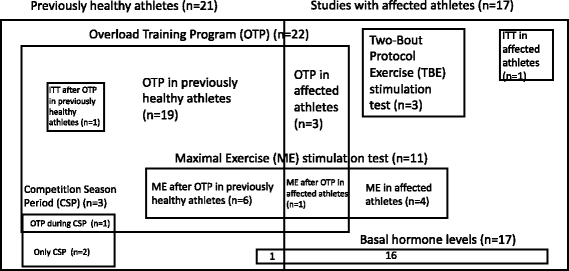Hormonal aspects of overtraining syndrome: a systematic review
- PMID: 28785411
- PMCID: PMC5541747
- DOI: 10.1186/s13102-017-0079-8
Hormonal aspects of overtraining syndrome: a systematic review
Abstract
Background: Overtraining syndrome (OTS), functional (FOR) and non-functional overreaching (NFOR) are conditions diagnosed in athletes with decreased performance and fatigue, triggered by metabolic, immune, hormonal and other dysfunctions and resulted from an imbalance between training stress and proper recovery. Despite previous descriptions, there is a lack of a review that discloses all hormonal findings in OTS/FOR/NFOR. The aim of this systematic review is to evaluate whether and which roles hormones play in OTS/FOR/NFOR.
Methods: A systematic search up to June 15th, 2017 was performed in the PUBMED, MEDLINE and Cochrane databases following PRISMA protocol, with the expressions: (1)overtraining, (2)overreaching, (3)overtrained, (4)overreached, or (5)underperformance, and (plus) (a)hormone, (b)hormonal, (c)endocrine, (d)adrenal, (e)cortisol, (f)GH, (g)ACTH, (h)testosterone, (i)IGF-1, (j)TSH, (k)T4, (l)T3, (m)LH, (n)FSH, (o)prolactin, (p) IGFBP-3 and related articles.
Results: A total of 38 studies were selected. Basal levels of hormones were mostly normal in athletes with OTS/FOR/NFOR compared with healthy athletes. Distinctly, stimulation tests, mainly performed in maximal exercise conditions, showed blunted GH and ACTH responses in OTS/FOR/NFOR athletes, whereas cortisol and plasma catecholamines showed conflicting findings and the other hormones responded normally.
Conclusion: Basal hormone levels are not good predictor but blunted ACTH and GH responses to stimulation tests may be good predictors of OTS/FOR/NFOR.
Keywords: Adrenal; Cortisol; Hormone; Overreaching; Overtraining; Sports endocrinology.
Conflict of interest statement
Ethics approval and consent to participate
This systematic review did not include direct human material or data, but indirectly used human subjects from the selected studies. However, all the selected studies had a statement of approval by an ethics committee. Thus, we declare that ethics approval and consent to participate is not applicable to this study.
Consent for publication
We declare that the consent for publication is not applicable to this study.
Competing interests
The authors declare that they have no competing interests.
Publisher’s Note
Springer Nature remains neutral with regard to jurisdictional claims in published maps and institutional affiliations.
Figures
References
-
- Meeusen R, Duclos M, Foster C, Fry A, Gleeson M, Nieman D, Raglin J, Rietjens G, Steinacker J, Urhausen A, European College of Sport Science. American College of Sports Medicine Prevention, diagnosis, and treatment of the overtraining syndrome: joint consensus statement of the European College of Sport Science and the American College of Sports Medicine. Med Sci Sports Exerc. 2013;45(1):186–205. doi: 10.1249/MSS.0b013e318279a10a. - DOI - PubMed
-
- Le Meur Y, Hausswirth C, Natta F et al. A multidisciplinary approach to overreaching detection in endurance trained athletes. J Appl Physiol 1 February 2013 Vol. 114 no. 3, 411–420. - PubMed
LinkOut - more resources
Full Text Sources
Other Literature Sources
Miscellaneous


